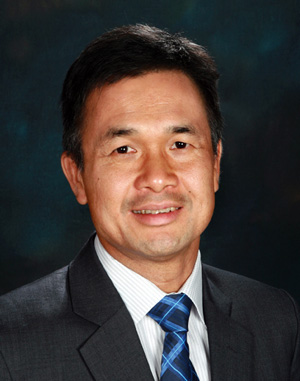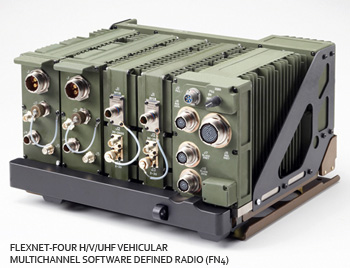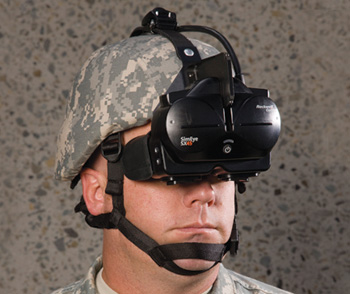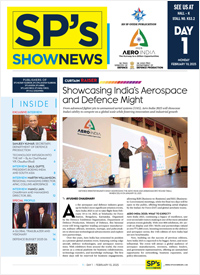- Prime Minister Narendra Modi inaugurates Aero India 2023 in Bengaluru; Releases Commemorative Stamp
- Defence Secretary meets delegations from Saudi Arabia, USA and Oman on the sidelines of Aero India 2023
- Foreign Ministers of 32 countries to attend Aero India 2023
- Embraer showcases the C-390 Millennium at Aero India 2023
Rockwell Collins' growing operations in India
T.C. Chan, Vice President and Managing Director-Asia Pacific, Rockwell Collins

SP’s ShowNews (SP’s): What has been your experience with the Indian defence market? What difficulties do you face in marketing your products to them?
T.C. Chan (Chan): No difficulties, just differences. For example, we have been doing business with the US Department of Defense since long. Its procurement process focuses on "best value". This means that even though a solution may be a bit more costly, if it brings more capability that can make the offer a 'better value' than the competition, the Department of Defense might still select it at a higher cost.
In contrast, the Indian Ministry of Defence process selects the "lowest cost, technically compliant" solution. There is no extra credit given for bringing more capability than is required by the request for proposal (RFP). We've also noticed that some RFPs appear to be tailored around specific point solutions, which can present new challenges.
We plan to leverage our experience in developing best-in-class solutions, as well as our in-country workforce, to address Indian needs.
SP’s: What is the extent of your local presence in India?
Chan: We're pleased and proud to have an established local presence with our India Design Centre (IDC), which we opened in Hyderabad in 2008. The centre offers engineering expertise in a wide range of areas, including software and hardware engineering design, systems engineering and software quality engineering. This local presence gives us a greater opportunity to recruit top talent from India's outstanding engineering pool.
With the IDC, we're able to support local and international customers with round the clock engineering services. Given the IDC's lower operating costs, this also helps our customers achieve lower programme life-cycle costs.
More recently, we opened a facility in New Delhi that focuses on sales and marketing, and programme management related activities. We currently have about 450 employees in India, with plans to grow to around 600 over the next few years.
SP’s: What objectives and targets has Rockwell Collins set for India and what joint ventures are under way within the public sector and with private Indian industries?
Chan: We've been pursuing a number of opportunities in India. In the public sector, we have contracts in place with the Electronics Corporation of India Limited and the Hindustan Aeronautics Limited. We've also been exploring ways to work with Bharat Electronics Limited.
We are always open to opportunities to do business with private Indian industries and are actively seeking partnerships with in-country Indian companies to further develop the Indian technology base.

SP’s: What software defined radios (SDRs) do you offer? Do they operate on multiple wavelengths and can they communicate with legacy radios of the Indian defence forces?
Chan: Rockwell Collins has a long history with radios and has been an industry leader in the development of SDR technology. To this end, we offer a variety of SDRs for a variety of capabilities and form factors to meet a spectrum of user requirements.
We have an airborne SDR-based on our ARC-210 generations 4 and 5-that operates in the V/UHF bands. We also have a V/UHF fixedsite SDR based on our proven 721S product line. And we offer the FlexNet-One and FlexNet-Four SDRs for ground mobile applications. FlexNet-One covers the V/UHF range. FlexNet-Four spans from two to 2,000 MHz, covering the HF, VHF, UHF and L-Band frequency ranges. All of them are designed to software communications architecture standards.
Being compliant to software communications architecture standards doesn’t mean that any SDR can “talk” with any other right out of the box. However, it does make it possible to port waveforms running on the Indian defence forces legacy radios onto our radios for interoperability with legacy and future Indian radio systems.
SP’s: Does Rockwell Collins have a small satellite communication (SATCOM) terminal suitable for single-person transport and operation in mountainous terrain, at high altitudes and by Special Forces?
Chan: Yes, indeed. OurmiSAT man-portable SATCOM terminal is one of the lightest and most portable in its class. It is ruggedised to military standards and sets up from storage configuration to deployment transmission in five minutes. We also offer ground transportable, ground fixed, airborne and maritime SATCOM terminals.
SP’s: Does Rockwell Collins plan to compete for the battlefield management system (BMS) planned for acquisition by the Indian Army, especially considering that the central armed police forces in India, which are engaged in counter-insurgency and counter-terrorism, will also eventually acquire such a system?
Chan: The BMS is definitely of interest to us and aligns well with our technology capabilities. With BMS, the Indian Army is taking concrete steps toward achieving network-centric operations (NCO), both strategically and tactically. NCO requires the integration of sensors, shooters and decision-makers, and the core of it all is a communications infrastructure that can provide robust networking-something we do very well.
Rockwell Collins is able to bring a variety of proven capabilities through our extensive experience with software defined radios coupled with our soldier situational awareness and fires solutions called FireStorm. The flexibility in our systems means we can offer multiple sensor interfaces, providing the shooter with the tools to be fully informed during the decision-making process.
SP’s: What are the cost-effective options that Rockwell Collins can offer to Indian defence forces for information assurance; options that are of the programmable, plug-and-play variety? Can the buyer superimpose another security layer over the offered solution?
Chan: We have developed information assurance products that are based on commercial standards and are fully exportable to India. They blend highly secure, exportable crypto capability with commercial elements for costeffectiveness, flexibility and ease of implementation. And yes, the buyers can superimpose their solution over ours. Our technologies have shown interoperability with commercial high assurance Internet protocol encryption devices.
Rockwell Collins information assurance solutions are typically integrated with our communications products, but we also can offer them as a standalone option. Rockwell Collins excels at these sorts of blended military and commercial solutions in part because our business model is balanced between government and commercial technologies. When we see an advantage to integrating military and commercial capabilities in a customer solution, we’re in a unique position to do that seamlessly and cost-effectively for our customers.

SP’s: Simulation and training have progressed slowly in Indian defence forces. What technologies can Rockwell Collins offer in this sphere?
Chan: We offer technologies that enable training across the full spectrum-from instructor-led, computer- and web-based training to a virtual avionics trainer or full-fidelity simulator.
Our systems give operators (such as mission commanders, pilots and mounted soldiers) and maintainers effective ways to reach their highest level of preparedness. For that, you need a number of innovative technologies working together.
For example, if you want a pilot to make a seamless transition from a simulated training environment to the real battlespace, you need to make the training experience as close to the real thing as possible. We do that with high-fidelity image generation, dynamic model and terrain interaction, the industry’s largest environment database library and open systems architecture to keep the system state-of-the-art. And because we also are an avionics original equipment manufacturer, our training system can re-host the actual avionics that pilots will use in the cockpit.
Some of our latest simulation and training technologies include: EP-80 image generator; UH-60 flight training device; CORE instructor operating system; 2015HC projector; SimEye SX45 helmet-mounted display; radar simulation systems; and live virtual constructive training.
SP’s: What technologies for unmanned aerial vehicles (UAVs) can Rockwell Collins offer to India?
Chan: Most of our communication and aviation electronics are suitable for use in both UAVs and manned platforms. In fact, our sub-systems can enable a traditionally manned, general aviation aircraft to operate as a UAV as a mission dictates.
We offer a variety of UAV solutions for military applications as well as for homeland security, law enforcement or disaster recovery, where pilot safety or mission requirements prohibit manned aircraft.
Our technologies help UAVs complete their missions more safely and securely. For instance, we offer robust, assured data links for command and control, plus greater situational awareness for our military customers. We make flight-control technologies with patented algorithms that enable UAVs to do what was considered impossible before - undergo what ordinarily would be catastrophic damage, recover flight and safely land. You can watch our damage tolerance video and see for yourself: http://www.youtube.com/watch?v=dGiPNV1TR5k
SP’s: What technologies can Rockwell Collins offer to Indian security forces for homeland security in battling terrorism and insurgencies or for border surveillance?
Chan: We believe our satellite communication (SATCOM) product offerings and software defined radios would be of interest to the Indian security forces, in addition to our HF cellular capability.
The HF cellular concept is similar to the “cellular” phone or mobile phone concept. In a cellular telephone network, a mobile user initiates a call and the closest (or best-receiving) base station completes the call. In HF cellular, all of the radio sites within an HF network are set to scan the available frequencies (or channels) in automatic link establishment (ALE) mode, waiting for a mobile platform to initiate an ALE call.
It is estimated that manual (non-ALE) linking on the first attempt is successful less than 15 to 30 per cent of the time. By adding ALE, the first attempt success rate jumps to greater than 90 per cent (based on experience with the US Customs Service). By using an HF cellular architecture with multiple radio sites strategically placed throughout an area, the first attempt success rate is improved to greater than 98 per cent, with significantly improved link reliability and availability throughout the coverage area. Lower-noise communications are also provided as HF cellular selects the best channel and the best radio site.





